Complete Solutions to SECTION-II of chapter SAMPLE PAPER 2014 of Class 10 book with complete answers and questions
| Class 10 | BIOLOGY |
| Chapter | SAMPLE PAPER 2014 |
| GURUKUL | SECTION-II |
| Number Of Questions | 72 |
| Academic Year | 2023-24 |
Spinal and Cranial nerves
02:33View SolutionWith reference to the functioning of the eye, answer the questions that follow :
What is the shape of the lens during :
(a) near vision (b) distant vision ?01:11View SolutionDifferentiate between :
Corpus callosum and Corpus luteum (Function)02:34View SolutionDifferentiate between the following pairs on the basis of what is mentioned within the bracket.
Turgor pressure and wall pressure (Explain)01:21View SolutionDifferentiate between the following pairs on the basis of what is mentioned within brackets :
Disinfectant and Antiseptic (Definition).03:49View SolutionThe diagram given below represents the simplified pathway of the circulation of blood. Study the same and answer the questions that follow :

Name the blood vessels labelled 1 and 202:28View SolutionThe diagram below represents the simplified pathway of the circulation of blood. Study the same and answer the questions that follow :

Name the blood vessels labelled 1 and 2.01:50View SolutionThe diagram given below represents the simplified pathway of the circulation of blood. Study the same and answer the questions that follow :

What is the importance of the blood vessel labelled 6?02:35View SolutionThe diagram below represents the simplified pathway of the circulation of blood. Study the same and answer the questions that follow :
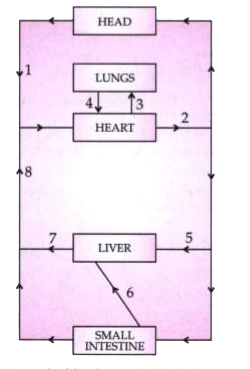
Which blood vessel will contain a high amount of glucose and amino acids after a meal ?01:58View SolutionThe diagram below represents the simplified pathway of the circulation of blood. Study the same and answer the questions that follow :
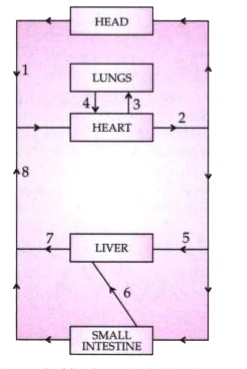
Draw a diagram of the different blood cells as seen in a smear of human blood.03:32View SolutionA candidate in order to study the process of osmosis has taken 3 potato cubes and put them in 3 different beakers containing 3 different solutions. After 24 hours, in the first beaker, the potato cube increased in size, in the second beaker, the potato cube decreased in size and in the third beaker there was no change in the size of the potato cube. The following diagram shows the result of the same experiment :
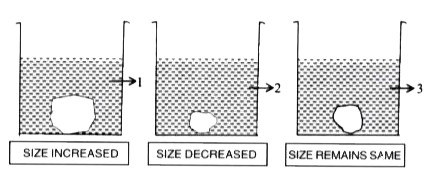
Give the technical terms of the solutions used in beakers, 1 , 2 and 3 .01:45View SolutionA candidate in order to study the process of osmosis has taken 3 potato cubes and put them in 3 different beakers containing 3 different solutions. After 24 hours, in the first beaker, the potato cube increased in size, in the second beaker, the potato cube decreased in size and in the third beaker there was no change in the size of the potato cube. The following diagram shows the result of the same experiment :
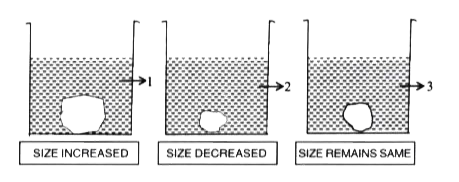
In beaker 3, the size of the potato cube remains the same. Explain the reason in brief.02:37View SolutionA candidate in order to study the process of osmosis has taken 3 potato cubes and put them in 3 different beakers containing 3 different solutions. After 24 hours, in the first beaker, the potato cube increased in size, in the second beaker, the potato cube decreased in size and in the third beaker there was no change in the size of the potato cube. The following diagram shows the result of the same experiment :

Write the specific feature of the cell sap of root hairs which helps in absorption of water.03:35View SolutionA candidate in order to study the process of osmosis has taken 3 potato cubes and put them in 3 different beakers containing 3 different solutions. After 24 hours, in the first beaker, the potato cube increased in size, in the second beaker, the potato cube decreased in size and in the third beaker there was no change in the size of the potato cube. The following diagram shows the result of the same experiment :
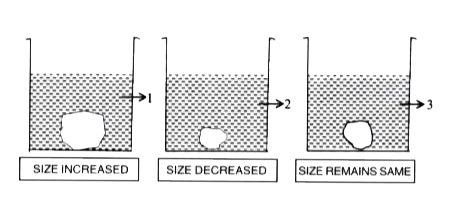
What is osmosis ?01:33View SolutionA candidate in order to study the process of osmosis has taken 3 potato cubes and put them in 3 different beakers containing 3 different solutions. After 24 hours, in the first beaker, the potato cube increased in size, in the second beaker, the potato cube decreased in size and in the third beaker there was no change in the size of the potato cube. The following diagram shows the result of the same experiment :
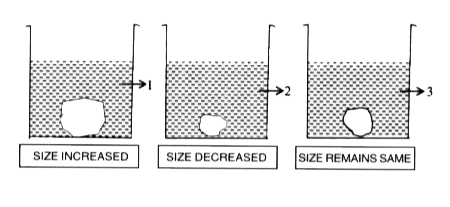
How does a cell wall and a cell membrane differ in their permeability?02:03View SolutionA candidate in order to study the importance of certain factors in photosynthesis took a potted plant and kept it in the dark for over 24 hours. Then in the early hours of the morning she covered one of the leaves with black paper in the centre only. She placed the potted plant in the sunlight for a few hours, and then tested the leaf which was covered with black paper for starch.
What aspect of photosynthesis was being investigated ?04:16View SolutionA potted plant with variegated leaves was taken in order to prove a factor necessary for photosynthesis. The potted plant was kept in the dark for 24 hours and then placed in bright sunlight for a few hours Observe the diagrams and answer the questions.
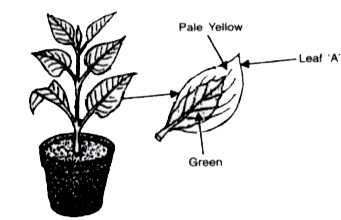
Why was the plant kept in the dark before beginning the experiment?02:12View SolutionA healthy Croton plant bearing variegated leaves was kept in a dark cupboard to destarch it after which it was placed in sunlight for a few hours. One of the leaves was then plucked and an outline of the leaf marking the green and the non-green regions was drawn. The leaf was then tested for starch. Using the above information, answer the following questions
Why is the leaf boiled in water and alcohol before testing for the presence of starch?02:14View SolutionA potted plant with variegated leaves was taken in order to prove a factor necessary for photosynthesis. The potted plant was kept in the dark for 24 hours and then placed in bright sunlight for a few hours Observe the diagrams and answer the questions.
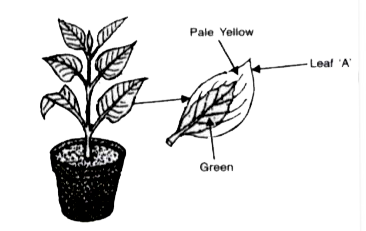
What aspect of photosynthesis is being tested in the above diagram?05:19View SolutionA potted plant with variegated leaves was taken in order to prove a factor necessary for photosynthesis. The potted plant was kept in the dark for 24 hours and then placed in bright sunlight for a few hours Observe the diagrams and answer the questions.
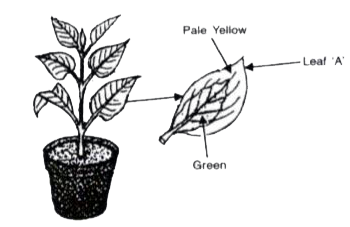
Draw a neat labelled diagram of a chloroplast03:24View SolutionThe diagram given below is a representation of a phenomenon pertaining to the nervous system. Study the diagram and answer the following questions:
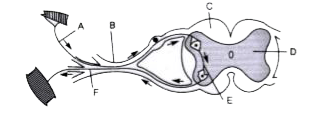
(i) Name the phenomenon that is being depicted.
(ii) Give the technical term for the point of contact between the two nerve cells.
(iii) Name the parts A, B, C and D.
(iv) Write the functions of parts E and F.
(v) How does the arrangement of neurons in the spinal cord differ from that of the brain.05:01View SolutionThe diagram given below shows the internal structure of a spinal cord depicting a phenomenon. Study the diagram and answer the questions:

Give the technical term for the point of contact between the two nerve cells.03:28View SolutionThe diagram given below is a representation of a phenomenon pertaining to the nervous system. Study the diagram and answer the following questions:

(i) Name the phenomenon that is being depicted.
(ii) Give the technical term for the point of contact between the two nerve cells.
(iii) Name the parts A, B, C and D.
(iv) Write the functions of parts E and F.
(v) How does the arrangement of neurons in the spinal cord differ from that of the brain.05:01View SolutionThe diagram given below is a representation of a phenomenon pertaining to the nervous system. Study the diagram and answer the following questions:

(i) Name the phenomenon that is being depicted.
(ii) Give the technical term for the point of contact between the two nerve cells.
(iii) Name the parts A, B, C and D.
(iv) Write the functions of parts E and F.
(v) How does the arrangement of neurons in the spinal cord differ from that of the brain.05:01View SolutionHow does the arrangement of neurons in the spinal cord differ from that of the brain?
01:25View SolutionUse of CFC is banned in many countries. Give scientific reasons.
02:28View SolutionGive biological reason for the following:
We cannot distinguish colour in moonlight. Give scientific reasons.01:57View SolutionBalsam plants wilt during midday even if the soil is well watered. Give scientific reason.
01:04View SolutionGive biological reason for the following:
Carbon monoxide is dangerous when inhaled.01:11View SolutionGive specific/biological reasons for the following statements.
A person after consuming alcohol walks clumsily.01:05View SolutionGiven below is a diagram representing a stage during mitotic cell division.
Study it carefully and answer the questions that follow:
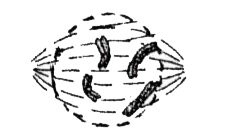
Is it a plant cell or an animal cell? Give a reason to support your answer.01:09View SolutionGiven below is a diagram representing a stage during mitotic cell division.
Study it carefully and answer the questions that follow:

Identify the stage shown above.03:12View SolutionGiven below is a diagram representing a stage during mitotic cell division. Study it carefully and answer the questions that follow :
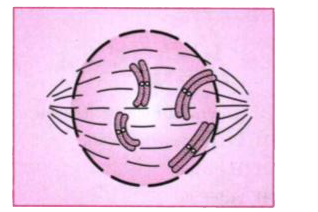
Name the stage that follows the one shown here. How is that stage identified ?03:41View SolutionGiven below is a diagram representing a stage during mitotic cell division.
Study it carefully and answer the questions that follow:
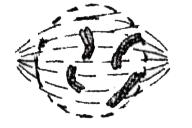
How will you differentiate between mitosis and meiosis on the basis of the chromosome number in the daughter cells?03:36View SolutionGiven below is a diagram representing a stage during mitotic cell division.
Study it carefully and answer the questions that follow:

Draw a duplicated chromosome and label its parts.02:42View SolutionName the disease for which following types of vaccines are given Salk's Vaccine.
02:01View SolutionName the disease for which following types of vaccines are given B.C.G.
01:05View SolutionName the following:
One water pollutant.02:46View SolutionGive one example of aquatic plant used in the lab to demonstrate `O_2`liberation during photosynthesis
02:54View SolutionDefine the following and give one example of Antibiotics.
01:11View SolutionA nitrogenous base in DNA.
02:01View SolutionExpand the following biological abbreviation ATP
01:54View SolutionExpand the following biological abbreviation :
(I) ACTH and TSH
(ii) TSH03:45View SolutionName the diseases against which DPT vaccine develops immunity.
01:29View SolutionExpand the DNA
02:19View SolutionThe given diagram represents a nephron and its blood supply. Study the diagram and answer the question :
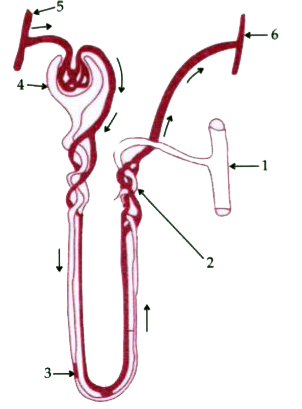
Label parts 1, 2, 3 and 4.03:55View SolutionThe given diagram represents a nephron and its blood supply. Study the diagram and answer the question :

State the reason for the high hydrostatic pressure in the glomerulus.02:31View SolutionThe given diagram represents a nephron and its blood supply. Study the diagram and answer the question :
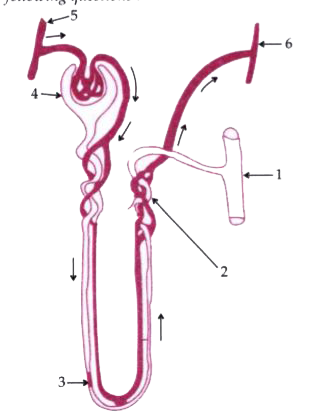
Name the blood vessel which contains the least amount of urea in this diagram.01:35View SolutionThe given diagram represents a nephron and its blood supply. Study the diagram and answer the following questions:

Name the two main stages of urine formation.03:03View SolutionThe given diagram represents a nephron and its blood supply. Study the diagram and answer the question :
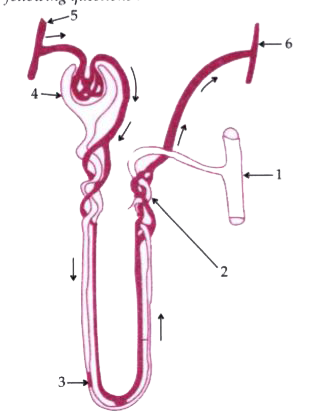
Name the part of the nephron which lies in the renal medulla.01:39View SolutionWhat is monohybrid cross?
01:40View SolutionBriefly explain biomedical waste.
03:42View SolutionAll the following are related to innate immunity except
02:13View SolutionDefine the following:
Diapedesis01:17View SolutionBriefly explain the Hormones
01:07View SolutionState any two harmful effects of noise pollution on human health.
02:07View SolutionCategorize the following activities as per the functions of the Red Cross Society and the WHO.
To suggest quarantine measures to prevent spread of disease.01:26View SolutionCategorize the following activities as per the functions of the Red Cross Society and the WHO.
Humanitarian services to victims of war.01:09View SolutionCategorize the following activities as per the functions of the Red Cross Society and the WHO.
To educate people in accident prevention.02:12View SolutionCategorize the following activities as per the functions of the Red Cross Society and the WHO.
To promote projects for research on disease.01:37View SolutionAnswer the following questions briefly.
List two reasons for the population explosion in India.01:17View SolutionState Mendel's law of segregation.
02:32View SolutionGive technical term for the following:
A method of contraception in which the sperm duct is cut and Iigated.01:23View SolutionGive biologicaVtechnical term for the following
Statistical study of human population.01:54View SolutionGive technical terms for the following:
The protective covering of the heart.01:54View SolutionGive technical terms for the following:
A sudden heritable change in the gene.02:29View SolutionThe repeated units of DNA molecule.
01:26View SolutionGive technical terms for the following:
; The fluid portion of blood.02:45View SolutionBased on the diagram drawn above in (i), give a suitable term for each of the following description.
The nerve that carries impulse from ear to brain01:17View SolutionGive technicallbiological term for the following:
(I) Hormone which stimulate other endocrine glands to produce their specific hormones.03:03View SolutionGive technical terms for the following:
Thin walled sac of skin that covers the testes.01:11View SolutionGive technical terms for the following:
The permanent stoppage of the menstrual cycle in a woman aged 50 years.01:18View Solution
SECTION-II questions and complete solutions for chapter SAMPLE PAPER 2014 of EVERGREEN BIOLOGY (ENGLISH) of Class 10
